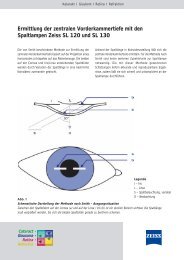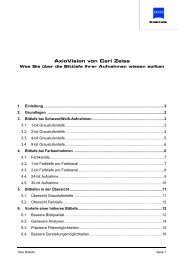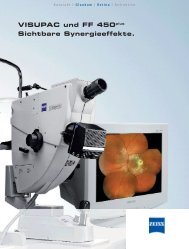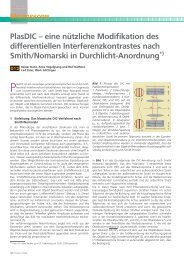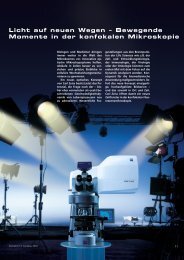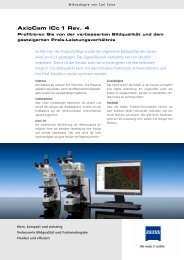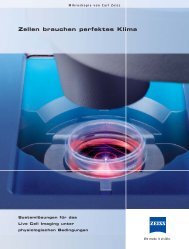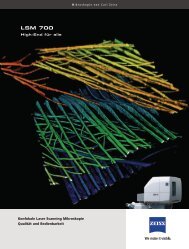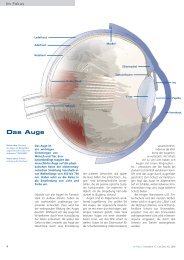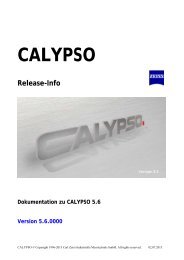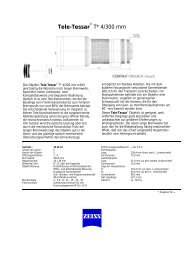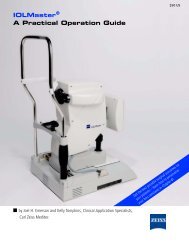FEMTO-LASIK and BEYOND - Carl Zeiss, Inc.
FEMTO-LASIK and BEYOND - Carl Zeiss, Inc.
FEMTO-LASIK and BEYOND - Carl Zeiss, Inc.
You also want an ePaper? Increase the reach of your titles
YUMPU automatically turns print PDFs into web optimized ePapers that Google loves.
June 2012 Supplement<br />
23<br />
I have seen less cases of patient discomfort, including dry<br />
eyes <strong>and</strong> foreign body sensation, <strong>and</strong> so far in my clinical<br />
experience with ReLEx smile I expect even less risk of<br />
corneal ectasia compared with <strong>LASIK</strong>. Regarding procedure<br />
time, I no longer have to move the patient from the<br />
femtosecond laser to the excimer laser, but rather I simply<br />
perform the cut <strong>and</strong> the refractive correction on the same<br />
patient bed at the VisuMax laser. There was a slight learning<br />
curve in which the procedure time was longer than it<br />
is for <strong>LASIK</strong>, but after I understood the ins <strong>and</strong> outs of the<br />
technique the surgical time decreased.<br />
Figure 1. View through the operating microscope immediately before<br />
completion of a ReLEx smile laser treatment using the VisuMax femtosecond<br />
laser.<br />
ReLEx smile. The main difference between ReLEx flex <strong>and</strong><br />
ReLEx smile is that there is no longer a need for a corneal<br />
flap. Instead, a small tunnel incision is created <strong>and</strong> the<br />
refractive lenticule is extracted through the incision using<br />
a spatula. The learning curve is slightly longer with ReLEx<br />
smile, but by 20 cases I had the technique perfected.<br />
Procedural advantages: My typical ReLEx smile procedure,<br />
which lasts approximately 10 minutes, is outlined<br />
below:<br />
• The patient is prepped for surgery by two drops of topical<br />
anesthesia <strong>and</strong> a lid speculum is inserted;<br />
• Using the VisuMax femtosecond laser, an intrastromal<br />
lenticule is cut <strong>and</strong> a 3-mm incision is created at the<br />
12-o’clock position. With a length of 500 μm, this small<br />
channel-like incision produces an entryway to the refractive<br />
lenticule (Figure 1); <strong>and</strong><br />
• The lenticule is loosened with a spatula <strong>and</strong> is manually<br />
extracted through the tunnel using a small forceps (Figure<br />
2).<br />
Surgically speaking, the ReLEx smile procedure has<br />
several advantages over excimer ablation techniques such<br />
as <strong>LASIK</strong> <strong>and</strong> PRK. Perhaps the largest is that I no longer<br />
have to create a preflap on the surface of the eye, meaning<br />
that I no longer have to worry about the complications<br />
associated with a corneal flap, such as buttonholes <strong>and</strong><br />
later flap dislocation. Additionally, there is minimal risk of<br />
epithelial growth under the flap, as only one small incision<br />
replaces the need for a flap, <strong>and</strong> there is more intact<br />
cornea compared with surface ablation procedures, which<br />
increases corneal stability.<br />
Clinically speaking, the main advantages are that the<br />
procedure is shorter <strong>and</strong> follow-up shows less variations.<br />
Higher-order aberrations: We have begun to analyze<br />
higher-order aberrations before <strong>and</strong> after ReLEx <strong>and</strong><br />
<strong>LASIK</strong>. Thus far, we have studied 3-month results for 100<br />
patients, 50 of whom underwent femtosecond <strong>LASIK</strong> <strong>and</strong><br />
50 of whom underwent ReLEx flex. Patients in the ReLEx<br />
flex group had fewer higher-order aberrations after surgery<br />
compared with femtosecond <strong>LASIK</strong> patients. Once we have<br />
longer-term results, we will repeat the same study using<br />
ReLEx smile patients. Since the process is similar to ReLEx<br />
flex, whereby the refractive lenticule is removed, we expect<br />
that the higher-order aberrations after ReLEx smile will be<br />
similar or even better than those after ReLEx flex.<br />
Figure 2. Lenticule removal is completed through a small<br />
incision in the ReLEx smile procedure.<br />
How can this difference in higher-order aberrations after<br />
ReLEx flex <strong>and</strong> femtosecond <strong>LASIK</strong> be explained? We<br />
postulate that, with <strong>LASIK</strong>, once the flap is cut <strong>and</strong> following<br />
the excimer laser ablation, there tend to be small<br />
decentrations that can lead to coma. However, with the<br />
ReLEx procedures this is avoided because any <strong>and</strong> all cutting<br />
is done within the cornea. More research is needed to<br />
confirm this hypothesis.<br />
Conclusion: ReLEx, <strong>and</strong> most specifically ReLEx smile,<br />
has become the new st<strong>and</strong>ard of care at our clinic for<br />
patients with high myopia. This treatment has many advantages<br />
over excimer ablation techniques, the most important<br />
two being a decreased number of higher-order aberrations<br />
after surgery compared with <strong>LASIK</strong> <strong>and</strong> the time it saves<br />
me in the operating room.



